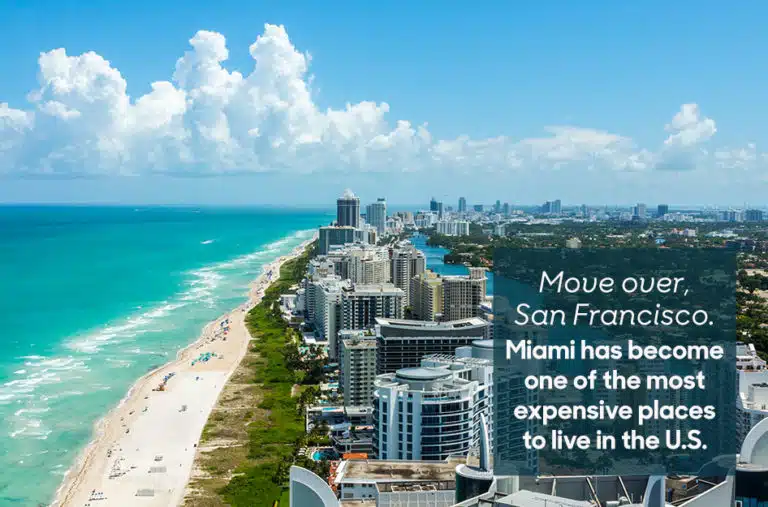
The Real Cost of Living in Miami: Can You Make It on a Budget in Magic City?
Florida Miami
With winter temperatures that seldom dip below 60 degrees, a thriving business climate, no state income tax, and leisure activities galore, it’s easy to see why people want to move to this place, aptly nicknamed the Magic City. But is living in Miami affordable? An intense real estate market and non-stop entertainment options might seem intimidating to your wallet. Do you really have the budget for the cost of living in Miami?
| Ready to move to Miami? Start by getting a quote from PODS. |
While the answer depends on your personal finances, this guide will explore Miami’s cost of living and share some of our best tips for how to save money if you choose to make this city your home.

The free Miami "Metromover" travels the tracks above the city, ferrying folks around downtown, Omni, and Brickell.
FAQs — Living in Miami on a Budget
Q: Can you live in Miami without a car?
A: It’s not easy to be a Miamian sans wheels. It’s doable, but not easy. For starters, living in Miami is hot, particularly during the brutal summer months, when you have the added pleasure of afternoon rains that drench the city nearly every day. But the Miami public transportation system is reliable — if not exactly comprehensive as it is in a place like, say, New York City. A combo of buses, trains, and trolleys will help you get around and lower your own particular cost of living in Miami. But do your homework first and make sure you’ve got a map, a weather forecast, and a schedule in hand. If all else fails, you can always rely on Uber or Lyft in the name of staying cool and dry.
Q: Is Miami a good place to live?
A: With a world-class arts scene (not all of which requires massive funds to explore!), status as a U.S. music mecca, and some of the best dining in the world, Miami is absolutely a good place to live. And, of course, much of that good living requires good money. But there are ways to make living in Miami affordable. So if you’re willing to make a few sacrifices here and there to figure out how to live in Miami and experience everything this international capital has to offer, it’s definitely a good place to live.
Q: What are the biggest issues in Miami?
A: The cost of living in Miami surely tops the list of challenges — in fact, it’s almost 19 percent higher than the national average and more than 15 percent higher than Florida’s. Crime is another issue. NeighborhoodScout gives Magic City a rating of 7, which means Miami is safer than only 7 percent of U.S. cities. But, as is the case in any major metro area, living in Miami provides plenty of options for neighborhoods where crime rates are lower. Fair Isle, for intown dwellers, and Kendale Lakes, for suburbanites, are among the safest areas in Miami, according to NeighborhoodScout.
Q: Why do people move to Miami?
A: The sunshine, of course! South Florida has 248 days of sun every year, which attracts not just older folks in search of retirement relief from the harsh winters up north, but younger families, as well. Add to that a thriving cultural scene — Art Basel, for instance, draws thousands every winter — and a diverse, vibrant population of immigrants who play a huge part in making up the culture of Magic City.
The Cost of Living in Miami Isn’t for Everyone
If you’re looking for a cheap place to live in Florida, Miami may not be your best bet. The cost of living in Miami is 19 percent higher than the national average, which isn’t too bad if you’re coming from high-cost-of-living cities like New York, D.C., and San Francisco. But it is a big jump if you’re moving locally or from a smaller city. To compare costs in Miami to where you live now, check out BestPlace’s Cost of Living Calculator.
Here are a few snapshots of what to expect when you move to Miami — and how to live in Miami on a budget:
Rent in Miami Is Higher Than the National Average
According to RentCafé’s national study, the average rent in the U.S. is just under $1,750 per month. By comparison, the average monthly rent in Miami is almost $2,650. Whether or not this feels like a huge expense will depend on where you’re moving from. Just about any other city in Florida, or even the Southeast? You’ll be feeling the jump. But if you’re moving south from an East Coast city like Washington D.C., New York, or Boston, housing costs — and the overall cost of living — in Miami might feel like a relief.
Utilities Are a Smidge Lower (Thanks, Sunshine!)
Surprisingly, utilities for families living in Miami are not much lower than the national average. The average cost for utilities for an apartment in Miami will run you about $246, a little bit less than the $253 national average. That bill includes basic electricity, garbage service, water, and heating
Food Is a Little Pricier — But Totally Worth It!
Miamians spend about 8 percent more than the national average on groceries. For a family of four, that comes to about $14,100 a year — if you’re frugal and cook at home. Dining out is another story, of course. The average meal for two, not including a tip, will run you about $100. And beware: The rich international flavor of Miami’s culinary scene might be a temptation that proves tough to resist.
Transportation Is Limited, So Don’t Give Up Your Wheels
If you’re taking public transit in Miami, you should know that a one-way fare on the bus or MetroRail is $2.25 — cheaper than in some larger cities. But transit is far more limited than in most other major cities (except in the rest of Florida, where it’s practically nonexistent), so most Miami residents need a car.

Depending on your income, budgeting is likely the way to go if you want to live comfortably in Miami.
You’ll Need a Six Figure Salary To Live Comfortably in Miami
Now that you have some data on your potential day-to-day expenses and the cost of living in Miami, we’ll break down the number to end all numbers — salary.
So, how much do you need to make to live in Miami? Florida’s average salary is about $49,260, but you will need to beat that to live comfortably in Miami. Let’s follow the 30 percent rule that states you should spend no more than 30 percent of your monthly income on housing.
So, if you spend $2,650 per month on rent, that means you should make almost $8,800 per month and almost $106,000 annually if you want to live alone, comfortably.
In order to make these expenses more attainable, it’s generally wise to split the bills with a significant other or roommate.
|
The PODS Blog is your one-stop shop for all things Miami moving. |

You can’t beat the sunsets in the Sunshine State — or the tropical shade on tree-lined streets in downtown Miami.
It’s Possible (We Promise!) To Find Affordable Neighborhoods in Miami
The No. 1 question from potential Magic City residents: How do people afford to live in Miami? Since rent will be your biggest expense while living in Miami, we’ll start here. Before you even make the move, take into account that the neighborhood you choose will play a major role in determining your costs. Central parts of the city, beach areas, and business centers tend to be quite expensive. But if you’re willing to settle for a longer commute or less access to certain amenities, you can find housing that’s much more affordable. Here are a few of our favorite neighborhoods with a lower price point to make managing the cost of living in Miami easier to bear.
Get Artsy in Coconut Grove
A lovely and popular neighborhood, “The Grove” is a laid-back neighborhood historically home to artists and writers. You’ll love how pedestrian-friendly Coconut Grove is — especially with the beautiful gardens and art deco residences to explore. Average rent in Coconut Grove is $3,500, but it’s still possible to find apartments in this area closer to $1,600 per month if you hunt hard enough.
Love the Burbs? Try Kendall
A comfortable suburb a bit removed from the wilder aspects of Miami, Kendall is a fantastic option if you’re looking to save for a mortgage or pay off loans. The community is small, so an “average” rent is hard to pinpoint, but you can find a 1-bedroom apartment for under $2,000 a month.
Little Havana Thrives as a Vibrant Cultural Hub
The epicenter of Miami’s Cuban culture, Little Havana is an area full of history where many Cuban refugees settled in Florida. Anchored by a strong community feel and residents who love their neighborhood, Little Havana is located west of downtown and features fantastic bar and restaurant options. Rent in Little Havana varies by area, but the average apartment goes for $2,650 per month.
Miami Suburbs Offer Family-Friendly Flair
As you might expect, the farther away from the heart of the city and the beaches you get, the lower your rent becomes — along with the overall cost of living in Miami. In addition to Kendall, areas like Hialeah, North Miami, North Miami Beach, Miami Gardens, and Miramar all offer less accessibility, but come with rents in the $2,000 range. If you’re working from home or you’re not invested in staying close to the heart of the city, you can make the budget work in the Miami burbs — and you’ll definitely still enjoy the Miami weather.
| New to Miami or considering making the move? Check out our guide to the Best Miami neighborhoods. |
6 Tips To Beat the Cost of Living in Miami
Living on a budget is challenging in any city, but with Miami’s outstanding weather and free recreation and entertainment opportunities, you can make it work in the Magic City. These tips will help you save money while still enjoying the good life.
1. Enlist the Help of a Realtor
If you’re on the lookout for cheap apartments in Miami, one of the best things about renting here is that you can use a realtor for free: Building owners pay all fees. So, there’s really no downside! The upside, among many things, is that you’ll be working with a professional who is familiar with different parts of Miami, and who can help find the best deal for you.
2. Share Expenses with a Roommate
If you’re really looking to live in Miami on a budget, consider not living solo. Instead of being responsible for the entire shebang of the Miami cost of living, including rent, deposits, utilities, internet, and other expenses, split the expenses with a roommate or two. You may be able to afford a nicer home in a more desirable neighborhood, as each of you will be paying for less of the pie.

Whether you’re a watcher or a doer, kiteboarding is a fabulous way to have fun around Miami’s breezy waterways.
3. Be a Wise Grocery Shopper
All grocery stores are not created equal! Take the time during your first few weeks in Miami to get the lay of the land in the grocery aisles at various stores near you. Aldi and Costco, well-known for their affordable prices and healthy options, have several locations in the Miami area. Figuring out who has the best deals on produce, meat, dry goods, and dairy can save you big time in the long run. The No. 1 thing to avoid? Doing all your shopping at an upscale market – just because it’s convenient.
4. Enjoy Free and Discounted Entertainment
Living in Miami means plenty of fantastic and interesting things to do — many of which you can enjoy for free or at a discount. For instance:
- Watch kite surfers ride the wind and waves on Biscayne Bay: On a breezy day, all you need to do is find a spot to pull over and look up above Biscayne Bay, one of the top kitesurfing spots in the U.S.
- Head to your local library and get free passes to 14 museums and attractions: For art and culture, you can’t beat the Museum Pass Program, available through the Miami-Dade Public Library System, which offers free passes to any of 14 museums and cultural attractions -– including Vizcaya Museum & Gardens, Deering Estate, and even Zoo Miami! In addition, many of Miami’s museums and other cultural activities offer weekly or monthly days that are free or discounted for the public to enjoy.
- Enjoy this paradise of people-watching. If you’re just into taking in the sights and sounds, you’ll find Miami is truly unrivaled. Top spots include Ocean Drive and Lincoln Road Mall in South Miami Beach, Wynwood Arts District, and CocoWalk in Coconut Grove.

With 248 days of sunshine every year, living in Miami is nirvana for beach lovers (just be sure to pack your sunscreen!).
5. Get Outside
If you’re moving to Miami for the fantastic weather, take advantage of it! Hitting a movie at the megaplex? You’re living in Miami! Instead, pack a picnic or drink to-go and take a stroll on the beach. Paying each month for a pricey gym membership? Cancel! Take advantage of Miami’s green spaces, parks, and beach boardwalks for your run. Check out this complete guide to Miami-Dade County’s impressive array of parks and recreation activities. They even have a full list of EcoAdventures, including “Go with the Flow” — a hands-on educational program about Florida waterways like the Everglades -– for just $7.
6. Choose Public Transit or Biking Over Driving
Like we said, living in Miami and getting around without a car isn’t easy. But depending on your neighborhood and work location, opting to take public transportation or ride a bicycle (check out Citi Bike!) may be a much more enjoyable alternative to enduring a long commute — particularly given the cost of living in Miami. Test out a few options, do the math, and commit to a routine that will save you money.
Ready To Start Living in Miami?
If sun and surf and cultural delights are your cup of tea, it’s time to get to the Sunshine State. Make your Miami move a flexible one with PODS moving and storage. Have a portable container delivered right to your driveway where you can pack and load at your own pace. When you’re ready, your container will be delivered to your new home in Miami. One month of storage is built into every move so you can take your time with the unloading (and take as many beach breaks as you need!).
| Moving to a busy street in Downtown Miami? Check out PODS City Service — containerized moving specially designed for big-city moves. |
Shannon Jacobs is a Tampa-based freelance writer and frequent contributor to the PODS Blog. She has lived in Atlanta, the Berkshires, and Nashville, but always returns to the warmth of Florida’s Gulf Coast.
Editor’s note: For ease of reading, monthly rental prices were rounded to the nearest $25 and home values were rounded to the nearest $100.
Related Articles
Comments
Leave a Comment
Your email address will not be published. Required fields are marked *
